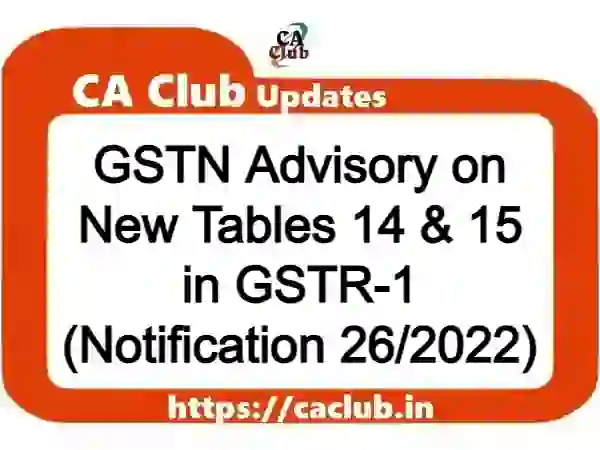GSTN has issued an advisory on new Tables 14 and 15 in GSTR-1, earlier introduced via Notification 26/2022. These tables will be available in GSTR-1/IFF from January 2024 tax periods onwards.
New Tables 14 and 15 were added to GSTR-1 to capture details of supplies made through e-commerce operators (ECOs). ECOs are liable to collect or pay tax under sections 52 and 9(5) of the CGST Act.
Purpose
(a) Notification 26/2022 introduced two new tables 14 and 15 in GSTR-1 and IFF forms.
(b) These tables are applicable for taxpayers who supply through e-commerce operators or are liable to pay tax under Section 9(5) of CGST Act.
(c) Table 14 captures a summary of supplies made through ECOs on which ECOs collect TCS under Section 52 or pay tax under Section 9(5).
(d) Table 15 captures invoice-level details of supplies made through ECOs on which ECOs pay tax under Section 9(5).
(e) The new tables 14 and 15 will be available in GSTR-1/IFF forms starting January 2024 tax periods.
(f) These tables are meant to provide details of supplies made through ECOs on which tax liability lies with the ECOs.
Table Wise Details
Table 14(a):
(i) Supplies through E-commerce Operators: This section is for suppliers who make sales through E-commerce Operators (ECO). They should report the ECO-GSTIN-wise summary of supplies on which the ECO is liable to collect tax at source (TCS).
(ii) Previous Reporting: The liabilities that have already been reported in any table from 4 to 10 of GSTR-1 should be included in this section.
(iii) Tax Liabilities: No taxable value or tax liabilities will be auto-populated from this table to GSTR-3B.
(iv) Amendments: Any amendments should be reported in Table 14A(a).
Table 14(b)
(i) Reporting Supplies: This section is for suppliers to report summary details of supplies made through E-Commerce Operators (ECO), where the ECO is liable to pay tax under section 9(5).
(ii) Tax Liability: The tax on such supplies is to be paid by the ECO, not the supplier. This should be reported net of any credit or debit note.
(iii) Auto-population: The values from this section will be auto-populated to Table 3.1.1(ii) of GSTR-3B.
(iv) Amendments: Any amendments should be reported in Table 14A(b).
Table 15
(i) ECO Reporting: ECOs are responsible for reporting the supplies on which they are liable to pay tax under Section 9(5). These supplies should not be reported elsewhere in GSTR-1/IFF.
(ii) Registered Supplier and Registered Recipient (B2B): ECOs should report the details of such supplies at the invoice level. Debit and credit notes, if any, should be reported in Table 9B.
(iii) Registered Supplier and Unregistered Recipient (B2C): ECOs should report supplier-level details along with the POS and rate-wise details of the supplies. This should be reported net of the credit or debit note, if any.
(iv) Unregistered Supplier and Registered Recipient (URP2B): ECOs should report the document-level details of the supplies made by the unregistered supplier to the registered recipient. The details should include the document details and GSTIN of the recipient.
(v) Unregistered Supplier and Unregistered Recipient (URP2C): ECOs should report the POS and rate-wise detail of the supplies from an unregistered supplier to an unregistered recipient. This should be reported net of the credit or debit note, if any.
(vi) Auto-population and Payment: The values shall be auto-populated in Table 3.1.1(i) of the corresponding GSTR-3B, and such liabilities are to be paid by the ECOs in GSTR-3B in cash.
(vii) Amendments: Any amendments should be reported in Tables 15A(I) and 15A(II).
Other Salient Features
(i) Auto-population in GSTR-3B: The taxable value and tax liabilities from all sections (B2B, B2C, URP2B, and URP2C) of table 15 will be automatically populated into table 3.1.1(i) of GSTR-3B.
(ii) E-invoice Reporting: There will be no auto-population of e-invoices in Table 15. E-invoices reported for section 9(5) supplies will be populated in FORM GSTR-1 as per existing functionality. E-commerce operators are advised to examine and add such records in Table 15 related to Section 9(5) Supplies.
Step to report details in Table 14/15:
Taxpayers can view Table 14/15 by navigating to the Returns Dashboard, selecting the period, and then going to ‘Details of outward supplies of goods or services GSTR-1’ > ‘Prepare Online’.
Taxpayers can access Tables 14(a) and 14(b) by clicking on the respective options available at the top of the page. Similarly, different sections of Table 15 can be accessed using the respective tab at the top of the page. After adding the records, taxpayers can file their GSTR-1 as per the existing process.
Introduction of new table ECO-Documents in GSTR-2B
(i) Input Tax Credit (ITC): Taxpayers can pass ITC to registered taxpayers receiving supplies under Section 9(5) through E-Commerce Operators (ECO). This ITC will be available in the newly introduced section in GSTR-2B.
(ii) ECO-Documents Table: A new table is added under all other ITC sections in GSTR-2B. Registered recipients can view document details of supplies received through ECO, where ECO is liable to pay tax under Section 9(5) of the Act.
(iii) Auto-population: Values from the Registered Supplier and Registered Recipient (B2B) and Unregistered Supplier and Registered Recipient (URP2B) sections of table 15 will auto-populate this new table.
(iv) Accessing the Table: Taxpayers can view the ECO-Documents table by navigating to Returns Dashboard > Selection of Period > Auto-drafted ITC Statement for the month GSTR 2B > View > ECO Documents.
https://tutorial.gst.gov.in/downloads/news/updated_advisory_new_table1415_cr23892_sj_10.01.2024.pdf
